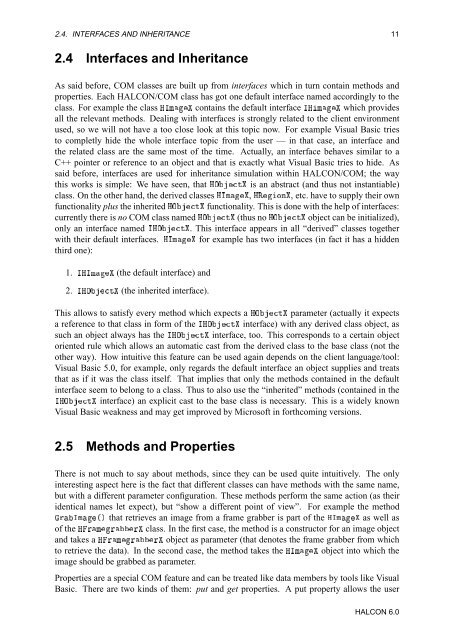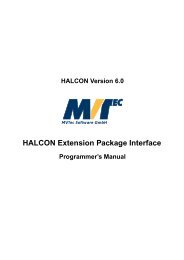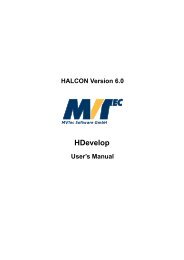HALCON/COM User's Manual
HALCON/COM User's Manual
HALCON/COM User's Manual
You also want an ePaper? Increase the reach of your titles
YUMPU automatically turns print PDFs into web optimized ePapers that Google loves.
2.4. INTERFACES AND INHERITANCE 11<br />
2.4 Interfaces and Inheritance<br />
As said before, <strong>COM</strong> classes are built up from interfaces which in turn contain methods and<br />
properties. Each <strong>HALCON</strong>/<strong>COM</strong> class has got one default interface named accordingly to the<br />
class. For example the class ÀÁÑ contains the default interface ÁÀÑ which provides<br />
all the relevant methods. Dealing with interfaces is strongly related to the client environment<br />
used, so we will not have a too close look at this topic now. For example Visual Basic tries<br />
to completly hide the whole interface topic from the user — in that case, an interface and<br />
the related class are the same most of the time. Actually, an interface behaves similar to a<br />
C++ pointer or reference to an object and that is exactly what Visual Basic tries to hide. As<br />
said before, interfaces are used for inheritance simulation within <strong>HALCON</strong>/<strong>COM</strong>; the way<br />
this works is simple: We have seen, that ÀÇØ is an abstract (and thus not instantiable)<br />
class. On the other hand, the derived classes ÀÁÑ, ÀÊÓÒ, etc. have to supply their own<br />
functionality plus the inherited ÀÇØ functionality. This is done with the help of interfaces:<br />
currently there is no <strong>COM</strong> class named ÀÇØ (thus no ÀÇØ object can be initialized),<br />
only an interface named ÁÀÇØ. This interface appears in all “derived” classes together<br />
with their default interfaces. ÀÁÑ for example has two interfaces (in fact it has a hidden<br />
third one):<br />
1. ÁÀÁÑ (the default interface) and<br />
2. ÁÀÇØ (the inherited interface).<br />
This allows to satisfy every method which expects a ÀÇØ parameter (actually it expects<br />
a reference to that class in form of the ÁÀÇØ interface) with any derived class object, as<br />
such an object always has the ÁÀÇØ interface, too. This corresponds to a certain object<br />
oriented rule which allows an automatic cast from the derived class to the base class (not the<br />
other way). How intuitive this feature can be used again depends on the client language/tool:<br />
Visual Basic 5.0, for example, only regards the default interface an object supplies and treats<br />
that as if it was the class itself. That implies that only the methods contained in the default<br />
interface seem to belong to a class. Thus to also use the “inherited” methods (contained in the<br />
ÁÀÇØ interface) an explicit cast to the base class is necessary. This is a widely known<br />
Visual Basic weakness and may get improved by Microsoft in forthcoming versions.<br />
2.5 Methods and Properties<br />
There is not much to say about methods, since they can be used quite intuitively. The only<br />
interesting aspect here is the fact that different classes can have methods with the same name,<br />
but with a different parameter configuration. These methods perform the same action (as their<br />
identical names let expect), but “show a different point of view”. For example the method<br />
ÖÁÑ´µ that retrieves an image from a frame grabber is part of the ÀÁÑ as well as<br />
of the ÀÖÑÖÖ class. In the first case, the method is a constructor for an image object<br />
and takes a ÀÖÑÖÖ object as parameter (that denotes the frame grabber from which<br />
to retrieve the data). In the second case, the method takes the ÀÁÑ object into which the<br />
image should be grabbed as parameter.<br />
Properties are a special <strong>COM</strong> feature and can be treated like data members by tools like Visual<br />
Basic. There are two kinds of them: put and get properties. A put property allows the user<br />
<strong>HALCON</strong> 6.0
















